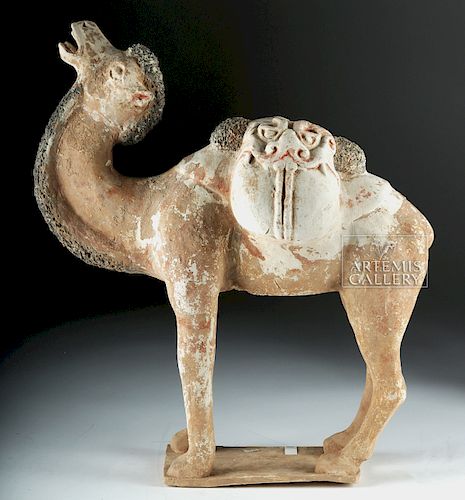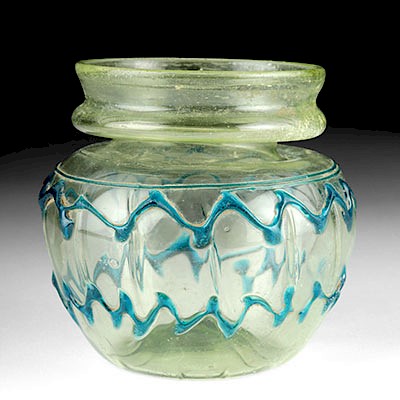Chinese Tang Dynasty Polychrome Camel, TL Tested
Lot 98
About Seller
Artemis Gallery
686 S Taylor Ave, Ste 106
Louisville, CO 80027
United States
Selling antiquities, ancient and ethnographic art online since 1993, Artemis Gallery specializes in Classical Antiquities (Egyptian, Greek, Roman, Near Eastern), Asian, Pre-Columbian, African / Tribal / Oceanographic art. Our extensive inventory includes pottery, stone, metal, wood, glass and textil...Read more
Estimate:
$3,000 - $4,500
Absentee vs Live bid
Two ways to bid:
- Leave a max absentee bid and the platform will bid on your behalf up to your maximum bid during the live auction.
- Bid live during the auction and your bids will be submitted real-time to the auctioneer.
Bid Increments
| Price | Bid Increment |
|---|---|
| $0 | $25 |
| $300 | $50 |
| $1,000 | $100 |
| $2,000 | $250 |
| $5,000 | $500 |
| $10,000 | $1,000 |
| $20,000 | $2,500 |
| $50,000 | $5,000 |
| $100,000 | $10,000 |
| $200,000 | $20,000 |
About Auction
By Artemis Gallery
Aug 16, 2018
Set Reminder
2018-08-16 10:00:00
2018-08-16 10:00:00
America/New_York
Bidsquare
Bidsquare : Clearance Sale - Ancient / Ethnographic Art
https://www.bidsquare.com/auctions/artemis-gallery/clearance-sale---ancient-ethnographic-art-3368
These lots are going, going, gone... plus a nice selection of lots brand-new to auction! Artemis Gallery info@artemisgallery.com
These lots are going, going, gone... plus a nice selection of lots brand-new to auction! Artemis Gallery info@artemisgallery.com
- Lot Description
**First Time At Auction**
Asia, China, Tang Dynasty, ca. 618 to 907 CE. A large, hollow pottery figure of a Bactrian camel wearing very distinctive saddle bags in the form of monstrous masked faces. This camel was made to be a tomb figure, known as mingqi. Tang dynasty elites had underground tombs full of pottery figures that were made to care for their every need in the afterlife. This figure was painted (rather than glazed, as others were), with black paint still visible around the saddle and a great deal of white and red paint visible, especially on the face. He stands on his own, his four legs attached to the integrated flat platform. The camel's head is curved back, his head up and mouth open wide. The monster masks on the sides may have been designed as wards to frighten evil spirits and protect the dead. Size: 8" L x 15.25" W x 17.75" H (20.3 cm x 38.7 cm x 45.1 cm)
The art of the Tang Dynasty is truly international, reflecting a world in which the Chinese court spread its influence through military conquest and trade to Central Asia, India, Persia, Africa, and southeastern Asia. In this prosperous period, Tang elites imitated the style of the Persians, wearing high boots, short tunics, and leopard skin hats. Music, sport, and dance all emulated Central Asian styles and made them their own. Nothing is more representative of this cultural milieu than the figure of the Bactrian camel who, with his saddle bags, carried so many of these goods and, by extension, practices east and west along the Silk Road. Travelling west from the Tang capital, Chang'an, the Silk Road passed through Taklamakan Desert. The Bactrian camel was vital to this transport because of its abilities -- to go without water for a week, to travel 30 miles a day, and to carry hundreds of pounds, as well as to withstand very hot and very cold temperatures.
Compare this example, with the monstrous saddle bags, to a glazed one with a rider at the Art Institute of Chicago (1969.788a-b).
This piece has been tested using thermoluminescence (TL) and has been found to be ancient and of the period stated. A full report will accompany purchase.
Provenance: private East Coast, USA collection
All items legal to buy/sell under U.S. Statute covering cultural patrimony Code 2600, CHAPTER 14, and are guaranteed to be as described or your money back.
A Certificate of Authenticity will accompany all winning bids.
We ship worldwide and handle all shipping in-house for your convenience.
#136329Head has been reattached with some overpainting along the repair line, but otherwise the piece is in excellent condition, with much remaining pigment.Condition
- Shipping Info
-
All shipping is handled in-house for your convenience. Your invoice from Artemis Gallery will include shipping calculation instructions. If in doubt, please inquire BEFORE bidding for estimated shipping costs for individual items.
-
- Buyer's Premium



 EUR
EUR CAD
CAD AUD
AUD GBP
GBP MXN
MXN HKD
HKD CNY
CNY MYR
MYR SEK
SEK SGD
SGD CHF
CHF THB
THB















